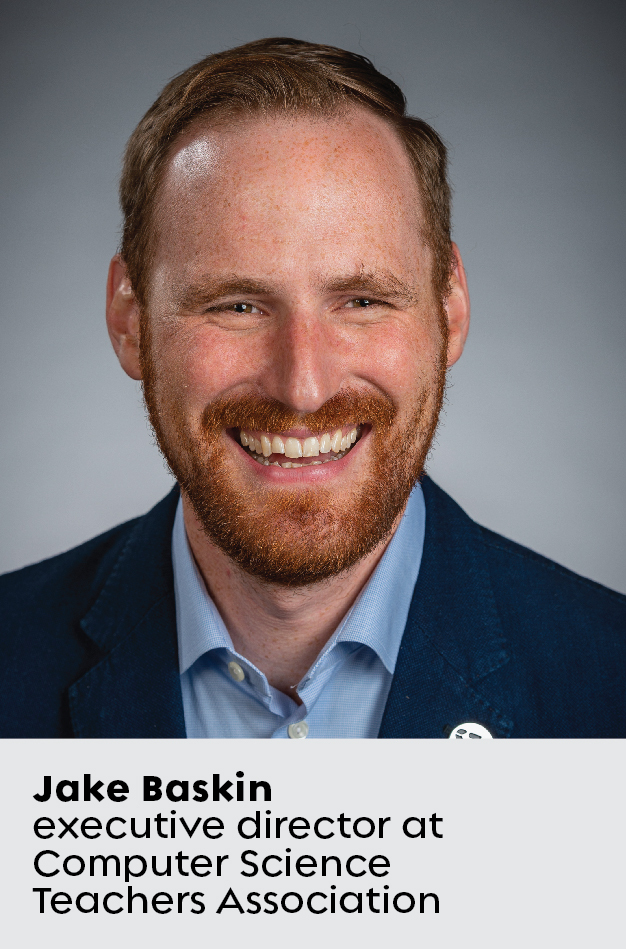To Strengthen Cybersecurity, Let's Support Our Tech Teachers
IT and cybersecurity departments are awash in tools, complexity—and empty seats. The Computer Science Teachers Association aims to fill those tech jobs.
Look around the typical high school and you’ll find functional groups that work much like those at a small college. There are departments for English, math, history, science, and so on. Each is staffed with perhaps a dozen teachers who share resources, knowledge, and goals.
Then there’s the one person who teaches computer science. This is typically a lone wolf with no peers to lean on—someone tasked with teaching one of the most essential subjects that today’s children need to learn.
One might think the world’s unwavering devotion to technology had brought computer science instruction into a golden age. Not so, says Jake Baskin, executive director of the Computer Science Teachers Association (CSTA), a nonprofit founded in 2004 that focuses on supporting K-12 computer science teachers around the world.
“We’ve made a lot of progress,” says Baskin, “but we are still far from where we need to be.”
That’s dire for several reasons. There is an enormous technology and cybersecurity skills shortage. This year’s ransomware attacks on businesses, infrastructure, and federal agencies have led to a race to hire more tech-savvy professionals.
Tanium’s Cyber Hygiene Assessment: An actionable path to better endpoint management and security
But employers can’t fill the roles fast enough. Information security and engineering jobs are expected to grow by nearly a third between 2019 and the end of this decade, according to the Bureau of Labor Statistics. This year alone, 500,000 info-security jobs in the U.S. will go unfilled, according to estimates by the Aspen Institute’s Cybersecurity Group.
“Introducing young students to cybersecurity principles can tremendously increase their knowledge and drive their interest in pursuing cybersecurity careers as adults,” says Charles Ross, chief customer officer at Tanium. “I am certain I wouldn’t have found my calling in this rewarding field if it weren’t for my high school computer science teacher.”
While nonprofits like Code.org are helping to provide computer science curricula to schoolchildren around the world—reaching hundreds of millions of kids in the process—enabling computer science teachers and filling out their departments remains a singular challenge.
“What we want is for every student to have a high-quality computer science education,” says Baskin. “And that can only happen if every student has effective computer science teachers.”
A virtual computer science department
Baskin’s teaching experience is familiar. In 2010, he found himself teaching computer science in a Chicago high school. While the school’s administration supported his work, Baskin was frustrated by the lack of peer support and internal guidance.
“Administrators or peers would come to observe my class,” he recalls. “They’d say, ‘I have no idea what you’re teaching, but everyone seems engaged, so keep doing what you’re doing.”I am certain I wouldn’t have found my calling in this field if it weren’t for my high school computer science teacher.
The fact is, Baskin didn’t know what he should be teaching. There was no one to consult. “I was honestly envious of my peers down the hall, who could go to a math department meeting and say, ‘Here are the courses we’re going to teach. Here’s how they fit together. Here’s how to deal with the struggles of teaching slope and variables.’”
[Read also: How Code.org is teaching the world’s school kids to code]
That frustration and feeling of academic isolation led him to look for resources outside the school, namely the then newly formed Chicago chapter of the CSTA. “All of a sudden I had found my people,” he says.
The chapter’s members were dealing with the same questions and teaching challenges as Baskin. CSTA’s support programs improved Baskin’s ability to teach computer science. It also changed his career. By 2018, he had become the head of the CSTA’s national organization, which now boasts 92 regional chapters.
CSTA provides resources for all teaching levels, from kindergarten through 12th grade. These include classroom materials, professional development resources, and certification opportunities. The nonprofit’s work reaches far beyond district-level issues to establishing progressive computer science education policies at the state level. The group supports a platform of nine policies it hopes to see enacted in every state.
Those policies include establishing K-12 computer science standards and curricula, allowing computer science to satisfy core graduation requirements, and requiring that all secondary schools offer computer science programs to all students. When the policies were initially developed, in 2013, just 14 states had enacted at least one of them. Progress is being made: Today, all 50 states have adopted at least one policy. More than half have adopted five or more.
Today’s challenges
Unfortunately, that progress isn’t uniform. The situation that computer science teachers find themselves in now remains tough.
Today, only 47% of high schools in the U.S. teach computer science at all. In some states, like Minnesota, that number is as low as 19%. Schools that primarily serve economically disadvantaged children are especially deprived when it comes to computer science education.
[Read also: Visibility and control: tackling the cyber threat epidemic in K-12 schools]
Only 34% of high schools where disadvantaged students make up 75% or more of the population have access to computer science. And across the board, the phenomenon of the lone computer science teacher persists, even in the most progressive school districts.
In U.S. schools where computer science is taught, the numbers are just as troubling. In a 2021 CSTA survey of nearly 3,700 computer science teachers, more than a third reported having inadequate materials, supplies, equipment, and space needed to teach their students. Less than half (46%) held credentials in computer and technical sciences.
[Read also: Inside Tanium: summer internship leads to full-time position with cloud engineering]
A major problem, says Baskin, is that schools almost invariably consider computer science an elective. The COVID-19 pandemic exacerbated the problem, he adds, noting that one in four high-poverty schools and 34% of rural schools had to suspend computer science instruction completely during the pandemic—just when computer skills were needed most.
While the business world has adapted to Zoom meetings and remote work, schools have not. “When push came to shove, computer science was one of the first things to be cut,” he says. “The impact has been that it is making it harder for students to learn computer science.”
How big business can help—and net bigger returns
That kind of short-sighted thinking is misguided, says Baskin, because computer science has a direct impact on culture, politics and business—and astute C-suite execs are taking note. Tanium, for instance, partners with CSTA through its 2% corporate giving pledge and its Talent of Tomorrow giving program. It has also joined an array of other leading firms, including Amazon, Google, Microsoft, Accenture, General Motors, Tesla and Uber, among others, to fund scholarships for high school and middle school computer science teachers participating in Code.org educational workshops.
Such investments can pay substantial dividends, most immediately a smarter, stronger pool of job applicants in the next five to 15 years. Computer science offers so many advantages to the children who learn it. Higher rates of college enrollment and improved focus, planning, and coding skills have all been linked to computer science education and lessons in computational thinking. “Computer science obviously includes programming and using computers to solve problems,” he says, “but it’s also important that we introduce ideas of how computer science can have a broader impact on the world.”
I’ve heard this a few times, but it feels like we’re losing ‘World War III’ right now and we don’t even know it.
That includes understanding the biases built into computer systems, the ethical implications of technology, and the increasingly critical importance of security in today’s technology environment.
There’s also a strong vocational aspect when kids learn computer science. Never mind that new college graduates with computer science degrees are earning more than those with any other major, according to a 2020 survey. There are so many available jobs in the field that new grads have a mountain of options when it comes to where to live and whom to work for. For example, a recent Wall Street Journal story noted that roughly 900,000 IT-related jobs went unfilled in a three-month period in 2019.
For Baskin, one of the biggest opportunities that computer science provides can be found in teaching cybersecurity. “I’ve heard this a few times, but it feels like we’re losing ‘World War III’ right now and we don’t even know it,” he says. “Security is a growing sector where it is going to be essential for us to develop talent.”
[Read also: 4 industries that are ready for what’s next]
But ultimately, Baskin, like many others, understands that computer science has become a part of daily life. No one can ignore it for fear of being left behind by the rest of society.
“I know that some high school students—and certainly first- and second-graders—aren’t choosing what they learn based on a career down the line,” he says. “But if you don’t understand how the internet works or how an app on your phone works, the world’s going to seem like magic to you. You can’t be an engaged citizen anymore. This is our chance to really shift what that looks like.”








